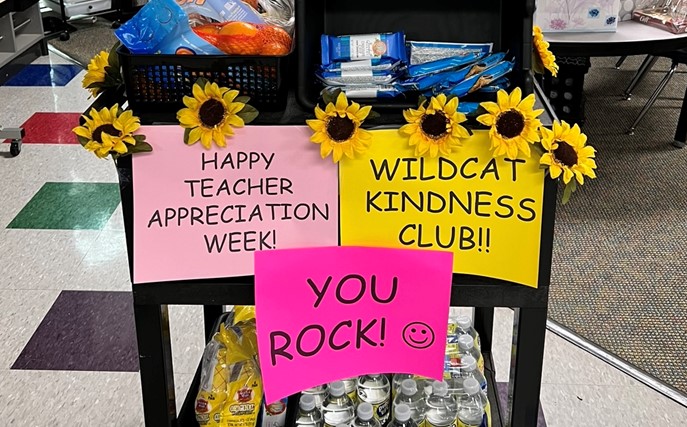Gratitude can be a powerful tool for contributing to a more positive school culture for students and staff alike. It can also:
- enrich students' social-emotional learning
- develop empathy and self-esteem
- boost mental health
- strengthen school-family partnerships
At the same, gratitude can show educators what's working. For example:
- Student appreciations of classmates may highlight qualities that a teacher might have overlooked.
- Staff appreciations may inspire colleagues to try something new.
- Taking time to hear what's working for families may yield some important insights.
- Teachers can learn how peers and colleagues are supporting English language learners (ELLs)
The following ideas highlight some ways to shine a spotlight on gratitude, with considerations that will ensure that English language learners (ELLs) and multilingual families are part of these activities.
Additional ideas, including tips for starting a personal gratitude practice, are available in the resources at the end of the article. The resource list also includes information about the research around gratitude in education and the archive of a social media chat with ELL educators focused on kindness and gratitude.
Thank you!
An article about gratitude needs a thank-you note! Thank you for all you do to support students, families, and your school communities every day!
Ideas for Students
1. Introduce the concept of gratitude and related vocabulary words.
Before starting a gratitude activity:
- talk about the meanings of words such as "grateful," "gratitude," and "appreciation"
- ask students to brainstorm student-friendly definitions for these words
- ask ELLs to share the meaning of "thank you" in their language
- make a display with "thank you" written in different languages, including in your students' languages (Thank you to Amanda Goman for sharing this idea on Twitter!)
You may wish to invite students to teach their classmates how to say "thank you" in their home languages. Talk with them about this beforehand, however, so as not to put students on the spot.
In addition, share models of sentence frames, messages, and notes that you might use in the activities below, such as:
Thank you for _______________.
___________ helped me by _______________.
I would like to express my gratitude for...
Quick tip
Tiffany Gordon, an ELL specialist and WIDA Fellow, color codes her sentence frames so that students know what they are reaching for in terms of language.
Video: Using sentence frames with ELLs
ESOL specialist Sheila Majdi from Arlington, VA explains what a sentence frame is and how she might use this strategy with ELLs.
2. Ask students to brainstorm examples of kindness and gratitude.
Ask students for examples of kindness and gratitude that they might see in their lives. You can also ask them to brainstorm on topics such as "How to welcome a new student." You may also wish to talk about how to welcome visitors to the classroom, as this class had done before ELL expert Beth Skelton arrived in the room. She writes, "I was the recipient of such a welcome in a 5th grade class. I walked in for an observation and a student stood up, shook my hand, welcomed me to the class, showed me to an empty chair, and offered me a glass of water!"
Teacher Ashley Singh shares examples of kindness from her classroom including, "The friendship my students have for each other. When we have a new student, the way they stand together and help them adjust to our school. The quiet encouragement in class. Waiting for each other at their lockers. Explaining the cafeteria food." And some schools are hosting Kindness Clubs to help spread kindness around the building.
3. Talk about gratitude during circle time or advisory period.
One way to start conversations about gratitude in the classroom is to make it the focus of circle time or discussions during homeroom or advisory periods. Some topics could include the following:
Can you think of a time when…
- a classmate helped you
- a teacher or other adult at the school helped you
- a relative helped you
- a neighbor helped you
- someone helped you during a difficult time
- something you are grateful for
- someone thanked you for something you did
You could also do a series of conversations with different themes each day during a "Gratitude Week" to explore the topic more in-depth.
Project idea
Using student responses, you might wish to create a "thankful tree," inspired by Daniel Tiger's "Thank You Day" story and episode.
Video: Finding a new friend after Hurricane Maria
When Nelson Rodriguez left Puerto Rico after Hurricane Maria, he quickly found a new friend in his teacher in Syracuse, NY, Jesus Ortiz. In this special video, they both remember the day they met and talk about the bond they formed.
4. Use writing prompts.
Use the prompts from activity #1 in a writing activity. Students could try different options based on their level of language proficiency:
- draw their responses
- write short sentences about their responses
- write a journal entry about their experiences
To support students' writing:
- Share examples of the kind of response you are looking for.
- Help students brainstorm their ideas with a graphic organizer.
Students could also start a gratitude journal, in which they make entries on a regular basis.
Video: Brainstorming a journal assignment with high school ELLs
Learn how high school ELL teacher Michelle Lawrence guides her students through the brainstorming process as they prepare to write a journal.
5. Write thank-you notes.
An additional extension activity is to write thank-you notes with your students. For example, students can write a thank-you note for:
- a person they mentioned in activity #1
- someone who has helped the class in some way
- a neighbor or community member
Sharing sample letters
Share examples of real thank you notes you have received with students, and then share a template that students can use so they can become familiar with the format. Here is a very basic example:
Dear ____,
Thank you for ______. This helped me because _____.
Sincerely,
__________
6. Set up an appreciation station.
This is a great way to shine a spotlight on positive things that are happening in the classroom or beyond. You could set up a board (either in the classroom or online) where students can post thank-you notes to their classmates and teachers. These could be posted on colorful post-it notes or note cards. Students can add to the board over time whenever they think of a new example to add. Examples might include:
- Fiona helped me study for the test.
- Ms. Robertson told me about a great book!
This blog post from Engaging and Effective shares ideas for creating an appreciation station, while teacher Maggie Gillis shares how she put together a gratitude wall in her classroom. Angela Singh writes, "My school started a 'Fishbowl' where students and teachers can write down acts of kindness they see other students perform or things they appreciate about other students/teachers so that we can celebrate everyone in our school community."
Note: Talk with students about the importance of treating this activity, and their school community, with respect. Let them know that any inappropriate notes will be removed.
7. Set up appreciation mailboxes.
In this activity, each student creates an envelope, folder, or "mailbox" in which classmates can leave an anonymous note of appreciation, such as, "You are a good soccer player," or "Thank you for making me laugh." The point is to find something positive for each person in the class. This can be a one-time activity, or something that is set up for much of the year (after students have gotten to know each other better). Again, it's important to stress the importance of respect with students before starting this activity or the activity below.
8. Create appreciation webs.
Another variation on the above idea is an appreciation web. Each student writes their name in the middle of a blank sheet of paper. Students then pass their papers in one direction and each student writes something they appreciate about the student whose paper they have in front of them. Then students pass the papers again until all students have contributed to each student's paper.
9. Share things you appreciate about your students with them.
Telling students what you appreciate about them can build confidence and give students things to appreciate about each other. Different ways to do this include creating a chart displaying something you appreciate about each student, or this educator's strategy of noticing great things about a few students each day, making a note of them, and then sharing them with the students.
Another option is to put sticky notes on student lockers with a kind message or note of appreciation, as shown in this school photo. And one teacher shared an idea on Twitter in which students had to "sneak" clothespins onto classmates' backpacks with positive notes on them.
10. Create a kindness club.
 First-grade teacher Amanda Tokko at Salina Elementary School created a kindness club called the Wildcat Kindness Club that focused on third graders.
First-grade teacher Amanda Tokko at Salina Elementary School created a kindness club called the Wildcat Kindness Club that focused on third graders.
For example, during the month of teacher appreciation, the club took a cart full of goodies (pictured here) around to classrooms to pass out to teachers.
11. Read a story about gratitude.
 The books on Colorín Colorado's Stories About Gratitude booklist highlight gratitude and appreciation across a variety of settings and cultures. These will make great read-alouds and for discussion.
The books on Colorín Colorado's Stories About Gratitude booklist highlight gratitude and appreciation across a variety of settings and cultures. These will make great read-alouds and for discussion.
You may also wish to look at a title like Be Kind from Language Lizard, which is available in multiple languages.
Ideas for Staff
12. Make space for gratitude and appreciation among the staff.
Highlighting gratitude and appreciation among staff members, especially during yet another taxing school year, can make a big difference in the staff dynamics. While it may take time for some staff members to warm up to this idea, sincere expressions of gratitude can go a long way in contributing to more collaboration, and as teaching coach Elena Aguilar writes, a more positive school culture.
Here are some ideas:
- Set up an appreciation station in a staff lounge or departmental office where staff can post thank-you notes.
- Set up public appreciation stations near places where different staff members work, such as the cafeteria, nurse's office, or guidance office.
- Share examples of ways that other schools are celebrating gratitude, such as some of the activities above or the example of this principal, who shares a weekly message that always includes something or someone from the school he appreciates.
- Start meetings with an appreciation focus. You might start with a round robin where each attendee shares something that another staff member did that they appreciate, or ask staff to volunteer examples of things that students or families have appreciated. At Salina Elementary School in Dearborn, MI, the principal led an activity where teachers wrote their name on a paper and then taped it to their back. Teachers walked around writing things they appreciated on each person's paper, and then each teacher pulled the paper off to read it. Staff were provided with frames so they could keep the paper as a memento.
In the same way that sharing success stories and celebrations among staff can lead to "a-ha" moments, this can also inspire some creative thinking and highlights some important contributions that might otherwise be overlooked.
Video: How thanking awakens thinking
Dr. Kerry Howells, a researcher specializing in gratitude and education, suggests that the key to creating fully engaged learners is to create an attitude of gratitude.
Family Engagement & Gratitude
13. Look for ways to emphasize gratitude in school-family partnerships.
There are many ways to make gratitude the focus of school-family partnerships. Here are some ideas you can try. Remember that all communication with multilingual families should happen in families' home languages and that families have a right to information in their home language.
- Send positive messages home and make positive phone calls. This can be a high-yield strategy that benefits student behavior, mental health, and family partnerships. Teachers who make positive phone calls home often report better behavior and partnerships with families that benefit students, families, and teachers alike. For multilingual families, you can talk with a family liaison about the best way to communicate, use a language line, or try an app like TalkingPoints.
- Thank families for ways they are contributing to the school or their students' education, whether in individual conversations or school-wide communication.
You can also invite families to:
- send in thank-you notes for a staff member who has helped their children
- email or text messages that the school can compile
- share examples with family liaisons who can pass them along to colleagues
- post a note on an outdoor appreciation station
14. Share success stories related to families.
Another way to harness gratitude in support of family engagement is to ask staff to share their own experiences with families related to appreciation. This might be things that families have appreciated, or it might be things that staff members have appreciated about families. This can highlight what families appreciate and value and also give other staff members some ideas on what to try.
Video: Helping families with food insecurity during COVID-19
Barbara Alicea, a bilingual family advocate for Brockton Public Schools (MA), talks about the challenges of food insecurity during COVID-19 — and the lengths her families have gone to show their appreciation for her hard work.
Ideas for the School Community
15. Consider a school-wide gratitude campaign.
If you want to go big, you might try a school-wide campaign to highlight gratitude in different classrooms and spaces throughout the school. For example, you could:
- set up a school-wide appreciation station can highlight contributions by students and different staff members throughout the school
- invite families to send thank-you messages to staff
- encourage individual teachers to use appreciation activities in their classroom
You can even share your experience with other schools or the local media to highlight the impact the gratitude campaign is having. This might just inspire others to do the same!
Professional Learning
Colorín Colorado has prepared a slide deck about gratitude that can be used for turnkey professional development sessions. It features several videos and activities for professional learning. Please share attribution to Colorin Colorado.
To get started, you need:
- Gratitude Slide Deck: Includes activities, discussion questions, and videos (also featured below)
To edit this presentation, you can download or copy the slides:
- File > Download (no Google account required)
- File > Make a copy (Google account required)
Closing Thoughts
Gratitude can be transformational, and small acts and message of gratitude can ripple outwards in big ways. Start small and build on your successes — now and all throughout the year!
Recommended Resources
Classroom strategies
- How to Create a Welcoming Classroom Environment for ELLs
- 6 Strategies to Help ELLs Succeed in Peer Learning and Collaboration
- Helping students create a true sense of belonging (Center for Academic Language Development)
- 25 Creative Gratitude Journal Prompts for Your Middle School Students (Calm Classroom)
Gratitude in the classroom: Resources from Edutopia
- Gratitude: A Powerful Tool for Your Classroom
- Cultivating a School-wide Culture of Authentic Gratitude
- Encouraging a Sense of Gratitude in Students
- Habits of Heart: Helping Students Reflect and Act on Gratitude
- 5-Minute Festival: Gratitude
- 4 Ways to Refuel Your Gratitude
- 41 Elementary Classroom Jobs to Build Shared Responsibility and Community
Gratitude journals
- Tips for Keeping a Gratitude Journal (GGSC)
- Why a Gratitude Journal for Students Is a Good Idea (Education Week)
Gratitude resources for families
- Seven Ways to Foster Gratitude in Kids (GGSC)
- 3 Ways to Practice Gratitude for Teens (TeensHealth)
- Help Your Child Develop Social Skills: Tips in English and Spanish (HITN)
- How to Practice Gratitude (Mindful)
Random Acts of Kindness
- 4 Reasons to Celebrate "Random Acts of Kindness Day" with Multilingual Learners (TESOL Blog)
- Random Acts of Kindness (Random Acts of Kindness Foundation)
- 5 Ideas for Random Acts of Kindness Day (Language Lizard)
Research on gratitude & education
- Gratitude in Education: A Radical View by Dr. Kerry Howells
- Expanding the Science and Practice of Gratitude (Greater Good Science Center at the University of California, Berkeley)
- How Gratitude Changes You and Your Brain (GGSC)
- Caring Relationships and High Expectations (California Safe and Supportive Schools)
For additional ideas and examples, see the archive of this Twitter chat on Talking About the Importance of Kindness and Gratitude with ELLs.








Add new comment